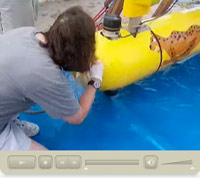|

 Today's Weather Mostly sunny Lat: 04° 03’S Long: 12° 16’W Air Temp: 78.8°F Bar Pressure: 1009. mbar Sea Temp: 79.9°F Sea State: 3-5 ft Swell Height: <7 ft, SE Wind: ESE; 11-13 knots Visibility: Unlimited
The Final Push It’s been a rollercoaster ride today for the scientists and engineers on board Knorr. Remember that last night we left Jaguar slowly moving along the seafloor because its altimeter, which measures its height above the bottom, stopped working correctly after it crashed into the bottom. Jaguar kept trying to drive into the seafloor to find the bottom. It didn’t “hear” the “abort” commands from the engineering team. Nevertheless, the loyal “cat” continued to try to drive along its pre-programmed survey lines until it reached the time when its mission was supposed to end. Then it shut down its thrusters and started to rise very, very slowly to the surface. Several hours later, when Jaguar reached a depth of 1,000 meters (0.6 mile) below the surface, the engineers sent it a signal to turn its thrusters back on and drive to the surface. This morning, we were thrilled to see the little yellow vehicle tossing in the swells and waving its orange flag. Once back on board the ship, scientists crowded around Jaguar to look for signs of its encounter with the seafloor. Using plastic gloves, geologist Ko-ichi Nakamura and geochemist Susan Humphris carefully removed some fine-grained “mud” off Jaguar’s nose and from the inside of its yellow “skins.” These samples will be taken back to their labs on shore for further analysis to determine whether they came from hydrothermal vents. Back in the lab, the engineers downloaded information from Jaguar’s “brain” while scientists looked on, desperately hoping to see images from the seafloor. Despite all of that angst, Jaguar delivered after all! Its strobe had indeed illuminated the pitch black of the deep ocean, and it captured thousands of digital pictures of the seafloor. Among the snapshots, we could identify volcanic rocks partly buried by a blanket of dark-colored sediments, blocks of old sulfides, and crabs and snails here and there. The sensors on Jaguar had also gone wild, picking up strong Eh and temperature signals. The only disappointment was that Jaguar never reached the area of the strongest signal detected by Puma. It completed about three lines of its survey (there were twelve lines planned) before it hit the bottom and its altimeter got confused. A visit to that “bull’s eye” area will have to wait for another trip. With less than 24 hours left—and the tick of the clock heard loud and clear—the science party must plan its final operations carefully. As oceanographers look to the future, they envision sending whole fleets of vehicles to explore the deep ocean. Turning that vision into reality is a long way off, but one of the goals of our cruise has been to take some of the first tiny steps towards it. We have tested navigation and communication technologies during single-vehicle missions, and it is now time to put Puma and Jaguar into the water at the same time to see if we can communicate from ship to AUV, and AUV to AUV. The lab is buzzing with excitement (and some trepidation) at the thought of both “cats” in the water at the same time. Just a few more hours until we get our chance to try it. Check back tomorrow to see how we did. It’s hard to believe, but tomorrow will be our final dispatch before we head into port at Ascension Island.Read the interview

Dan Conrad: Dan Conrad, who has taught physics for more than 20 years at Baltimore Polytechnic Institute, has a lifelong passion for both science and art. Read the interview »
[ Previous day ] [ Next day ]
|
||
Mailing List | Feedback | Glossary | For Teachers | About Us | Contact
© 2010 Dive and Discover™. Dive and Discover™ is a registered trademark of Woods
Hole Oceanographic Institution




